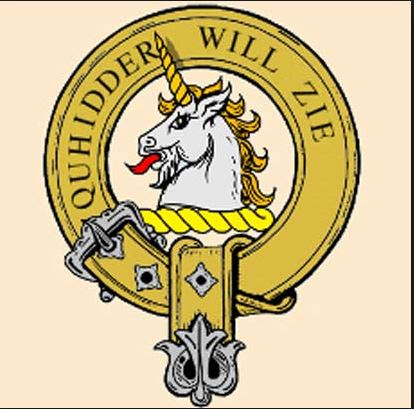Most of the Stewarts of Appin did not use the surname “Stewart”. The leadership of the Clan was held by the Chief and his many cousins, who were tacksmen who held minor estates in Appin as cadets of the chief. Many of the clansmen were descended from families which had lived in Appin long before the Stewarts arrived, including McColls, Clan MacLea, McQuorquodales and Carmichaels.
The Stewarts of Appin were traditional allies of the Clan MacLaren of Balquhidder, the Clan Cameron of Lochiel and the Clan MacDonald of Glencoe (or MacIans) of Glencoe. They were inveterate enemies of the Clan Campbell of Argyll and Breadalbane.
In 1497 some of the Clan MacLaren stole cattle from the Braes of Lochaber from the Clan MacDonald of Keppoch. The MacDonalds followed them and overtook them at a place called Glenurchy where a battle took place. The MacDonalds won and recovered their cattle. However the MacLarens then looked for assistance from Dugel Stuart of Appin. Another battle then took place where the MacLarens were now joined by the Stuarts against the MacDonalds. During the battle Dugel, the chief of the Clan Stewart of Appin and the Clan MacDonald of Keppoch chief were both killed.
They served with James Graham, 1st Marquess of Montrose and participated in Battle of Inverlochy (1645) where they defeated Archibald Campbell, 9th Earl of Argyll at Inverlochy Castle in February 1645. After James VII was deposed in 1688, the Stewarts of Appin supported the deposed House of Stuart.
The Stuarts naturally supported the Jacobite Risings and sent men to fight in both the The ‘Fifteen and The ‘Forty Five.
At the Battle of Culloden in 1746, the Stewarts of Appin suffered appalling casualties breaking the ranks of the Government Regiments of Foot of the British Army. Charles Stewart of Ardsheal led the men of Clan Stewart of Appin during the rising of 1745, and many fell at the grim field of Culloden, having first gained glory by breaking the Redcoat ranks. Colin Campbell of Glenure, ‘the Red Fox’, was placed as government factor on the forfeited Stewart estates. His murder in 1752 has been immortalised by Stevenson in the novel, Kidnapped. After the chief suspect, Alan Breck Stewart, made his escape, James Stewart, the half-brother of the chief, was tried by a jury composed entirely of Campbells at Inverary presided over by Argyll himself, and, perhaps not surprisingly, was convicted and hanged.
The most important cadet family of Appin were the Stewarts of Ardsheal. Traditionally, Ardsheal was the tutor to the minor Appin Chiefs. During the 1745 Jacobite rebellion, Charles Stewart of Ardsheal led regiment raised by the Stewarts of Appin. After Culloden, he fled to exile in France and his lands were forfeited to the Crown. His son succeeded in having the lands restored later in the 18th century and the Stewarts of Ardsheal succeeded to the chiefdom of Appin upon the extinction of the Appin family.




2 Comments
Just curious why the spelling of Stewart alternated between Stewart and Stuart when talking about the same Branch or person? I was recently in Appin and tried to see all the points of interest to the Stewarts. There was no information on most of these sites and other than James of the Glen’s execution and birthplace there was little else marked…no local museum either.
Hi
Simply put:
‘Stewart’ is the Scottish spelling
‘Stuart’ was used by Mary Queen of Scotts to help French pronunciation of Stewart and it stuck.
Same family line, Prince Charles Edward Stewart can equally be spelt as Prince Charles Edward Stuart. (Although I prefer the Scottish spelling)
Neil Stewart